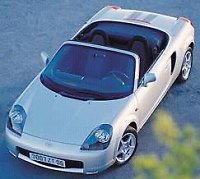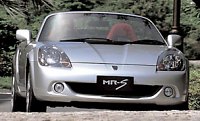 Mr.
Nakagawa is responsible for the development of both Celica and MR-S.
While
the recently launched Celica is well received by the public, he seems
to
be more nervous about the MR-S. He spent a lot of time to explain the
new
car to the press, stressed that his mission was to bring back the
agility
that made the first generation car so good. Mr.
Nakagawa is responsible for the development of both Celica and MR-S.
While
the recently launched Celica is well received by the public, he seems
to
be more nervous about the MR-S. He spent a lot of time to explain the
new
car to the press, stressed that his mission was to bring back the
agility
that made the first generation car so good.
He is right. The second generation MR2 was originally praised for being powerful. In normally aspirated form it produced 165hp (then rose to 173hp); Turbocharged version’s 225hp even earned it a name of "mini-Ferrari". But the public’s enthusiasm quickly calmed down. People started to complain about its grown up size and weight of around 1200kg. Criticised its downgraded steering feel and cornering agility. Last year, decline sales figure forced it withdrew from all markets except Japan. If you are old enough, you might remember how exciting the first generation MR2 was. It opened the eyes of European journalists, letting them to see the rising sun’s ability to create exciting sports cars. The 16-valves engine was powerful and years advancer than European. The mid-engined chassis balanced and felt so good, with brisk performance to match. That was 1985. 14 years later, the third generation car is going back to the basis. The name of the Mk3 might arise some confusion. In home market, it calls "MR-S" rather than MR2, the latter is used in elsewhere. The "S" stands for Spyder, in other words, Convertible. In terms of styling, the MR-S is another example demonstrating the incompetence of the Japanese studio. Despite of the deliberate imitation on Porsche Boxster (look at the front and rear lights !), its angular profile and poor execution of details make it uncomfortable to look at. Next time please ask the California studio (which styled Celica) or Brussel studio (which penned Yaris) for help.
.... until you fire the engine. The 1794 c.c. all-alloy 16-valver is equipped with VVT-i like all other new engines from Toyota. The reduction of 200c.c. drops power and torque to 140hp and 127 lbft respectively, but drivability is not deteriorated. Nakagawa believes 1.8-litre is the best optimized size for a four cylinder. It enables smaller radiator, smaller brakes, narrower tyres .... in short, a lighter and more nimble car. Kerb weight is just 975kg, exactly identical to the Mk1 MR2. This is a remarkable achievement, considering the crash protection requirement for 2000 is far stricter than those of the 80s, and then the new car has more powerful engine and a soft top. 14 years ago, it might not be the lightest (cars such as Bertone X1/9 and Honda CRX might be lighter). Today, it is some 100kg below the competitors.
In
terms of sheer handling, the little Toyota is unmatchable in its price
range, not even the ever-green Miata. But the latter has prettier
styling
and a sense of originality. The MR-S, like the first 2 generations, are
more likely to be the choice for boy racers, who don't like art and
philosophy.
Nevertheless, with the addition of convertible, the MR-S should appear
to the larger crowd. |
| The above report was last updated on 29 Nov 99. All Rights Reserved. |
 The
cabin is tight fit, thanks to the size reduction. The instruments do
what
they are intended to and no more. Lack of a stylish dashboard, lack of
high quality plastic as well as a decent trimming, you know price cut
is
the second biggest mission of Mr. Nakagawa. The steering wheel is
adjustable
in rake but not reach. The soft roof is operated manually, although it
stores neatly under a panel. So, inside and outside, the MR-S does not
deliver a good impression ....
The
cabin is tight fit, thanks to the size reduction. The instruments do
what
they are intended to and no more. Lack of a stylish dashboard, lack of
high quality plastic as well as a decent trimming, you know price cut
is
the second biggest mission of Mr. Nakagawa. The steering wheel is
adjustable
in rake but not reach. The soft roof is operated manually, although it
stores neatly under a panel. So, inside and outside, the MR-S does not
deliver a good impression ....  On
the road, the weight saving translate into excellent control. The
mid-engined
chassis has first rate balance. Although it rides on MacPherson struts
all round, the good set-up works well to keep the wheels perpendicular
to the black top. The electric-assisted steering feels superbly
communicative
and well weighted. 2.6 turns from lock to lock means quick response.
More
important, the new MR-S corners with the agility and throttle
adjustability
that remind us the first MR2 or Mazda MX-5. However, some may describe
it as "too tail happy", as it is easily prone to oversteer like Lotus
Elise,
thanks to the suspension setup and 56% weight taking by the rear axle.
Well, such people just deserve to drive a boring BMW Z3.
On
the road, the weight saving translate into excellent control. The
mid-engined
chassis has first rate balance. Although it rides on MacPherson struts
all round, the good set-up works well to keep the wheels perpendicular
to the black top. The electric-assisted steering feels superbly
communicative
and well weighted. 2.6 turns from lock to lock means quick response.
More
important, the new MR-S corners with the agility and throttle
adjustability
that remind us the first MR2 or Mazda MX-5. However, some may describe
it as "too tail happy", as it is easily prone to oversteer like Lotus
Elise,
thanks to the suspension setup and 56% weight taking by the rear axle.
Well, such people just deserve to drive a boring BMW Z3.
 To
most drivers, the biggest problem of MR-S is it is too keen on
oversteering.
Skillful drivers may see that as engaging, but if they drive the car in
a raining night, they have to be very careful. Responding to customer’s
criticism, Toyota made a revision in August 2002. From exterior, it
looks
like just a minor facelift which concentrates on bumpers. However,
underneath
the skin there are 2 major changes.
To
most drivers, the biggest problem of MR-S is it is too keen on
oversteering.
Skillful drivers may see that as engaging, but if they drive the car in
a raining night, they have to be very careful. Responding to customer’s
criticism, Toyota made a revision in August 2002. From exterior, it
looks
like just a minor facelift which concentrates on bumpers. However,
underneath
the skin there are 2 major changes.